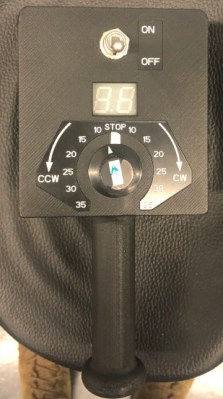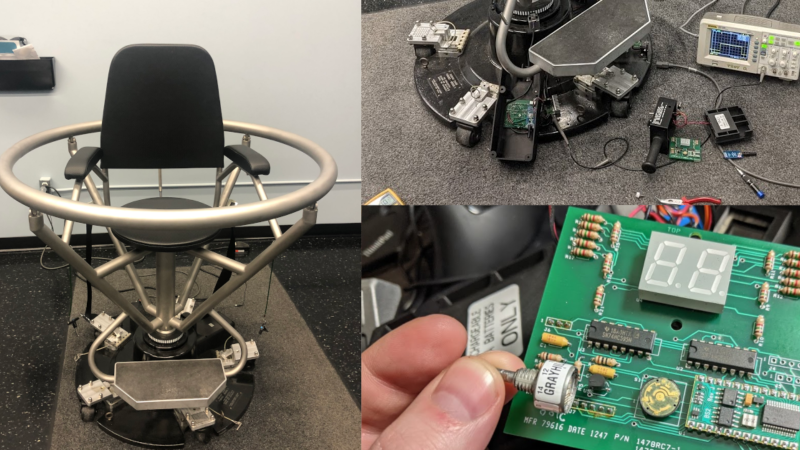Ever heard of a Bárány chair? Neither had [Troy Denton] before he was asked to repair one, but that didn’t stop him from rolling up his sleeves and tying to get the non-functional device back in working order. As it didn’t come with a user guide, manual, schematic or any other information, he had to rely on his experience and acumen gathered over years of practical work. Luckily for us, he decided to document the whole process.
 While it’s not well known outside of aviation circles, the Bárány chair is an important piece of equipment in training pilots to get used to spatial disorientation. The device is essentially a motorized revolving chair, the idea being to spin the subject to induce disorientation. Rotation speed and direction can be controlled via a handheld wireless remote terminal.
While it’s not well known outside of aviation circles, the Bárány chair is an important piece of equipment in training pilots to get used to spatial disorientation. The device is essentially a motorized revolving chair, the idea being to spin the subject to induce disorientation. Rotation speed and direction can be controlled via a handheld wireless remote terminal.
When [Troy] first powered it up, the error code on the remote indicated “no power to base unit”. That turned out to be a quick fix – he simply had to move the power connection from a switched socket that had been turned off to a different outlet. But while that cleared the error message, the chair still wouldn’t rotate for any of the knob settings.
Manually rotating the chair showed the RPM on the remote, so [Troy] narrowed down his search to the motor related sections. The motor was being driven by a servo type signal, but changing the speed and direction knob on the remote didn’t seem to alter the control signal when he checked it with his scope. Opening up the hand held remote immediately uncovered the failed part – the rotary encoder for setting the speed and direction had physically split in to two pieces.
Since there was a clean split in the encoder, he was able to temporarily hold it back together to confirm that the chair could spin up. The cause was most likely “User Error” – the last person to conduct the test probably turned the knob rather enthusiastically. A new part is on the way, and the chair should be getting back to making prospective pilots dizzy in no time.
We love a good repair story here at Hackaday. Whether it’s patiently rebuilding a snapped PCB with bodge wires or coming up with replacement parts that may well be better than the originals, we never get tired of seeing a broken piece of gear put back together.
Thanks to [Tim Gremalm] for the tip.
















If you get dizzy in the chair, you are going way too fast!
The “pilot” should be turned at about 2-3 rpm.
The varying speed is what causes disorientation. The ear says you are turning left, then slow it down and the ear says you are turning right.
The scale makes sense if it’s in degrees per second. 35 would be equivalent to 5.83 RPM.
Add rolling head from one shoulder to other at least that was the version we did in my glider pilot days in eastern europe.
Wait – this is a hackaday — Shouldn’t he have replaced the rotary encoder witha bluetooth module and written an app for a phone for it. Added some wifi and streaming control from the net?
Replaced broken part — nice job repair something most of us never hear of, but “hack”
I think Hackaday needs a flag that we can filter on to allow prioritizing/hiding based on repair, novel repair/use, hack, yet another arduino whatever.
I’ve not been a “hey that shouldn’t be on hackaday guy” but things are seeming to get lighter and lighter on hacks.
Maybe he could make it a case for a RasPi
I would have done it with a 555…
Where do I sign up for repairaday?
Ditto
Electronic repairs are absolutely hacks. Doubly so when done without any schematics or details on the hardware. Being able to open up a piece of hardware and figure out how it works is a crucial skill for hardware hackers. We should all spend some time poking around inside broken devices to sharpen our skills.
Cool story, bro.
The 3D version of this is amusing. I had a go in one a few years back. Definitely good fun. They look a bit like those kinetic gimballed desk toys but full size with a chair in the middle.
Sometimes the low tech is the bug to be found. I’d have caught this early as I open up things and look first at mechanical things like edge connectors and plastic pots and stuff holding the board to the panel. Most likely it was dropped and that broke the control. I am not a fan of circuit board mounted panel controls where the pots hold the rest of things in place.
Low tech is usually the issue when something stops working. It’s great when you *want* to make something stop working completely, like lockout/tagout, but otherwise, it often takes a $15 mechanical part to be close to as reliable as a $1 chip.
Some things like mechanical keyboard switches seem to be cheap and highly refined. But even ordinary microswitches aren’t totally perfect with those bendy little arms, and encoders, buttons, and connectors can definitely fail.
Meanwhile it’s usually flash storage, bad code, or power handling that fails on high tech, and once you get it working and use good power stuff, it usually just needs at most a reboot now and again, not replacement parts, as long as you don’t hammer the flash.
Talk about a blast from the past – that thing is based on a basic stamp! Remember those from parallax?
Hard to imagine the thought process that led them to a product based around one…
“Bárány” is French for “puke”, right?
It’s Hungarian for lamb. the consonant “ny” is similar to the Spanish “ñ”.
I wonder if that’s due to any similarity with devices for restraining sheep while they’re sheered. Or was it just the Originator’s name.
*sheared, dammit. The shear number of times that my fingers type the wrong one….
Bárány Róbert (in Eastern naming order) a Nobel laureate.
They had one of those in the Space Shuttle program that added a rotating star field and put a camera on the eyes victim/test subject. The point was to see how people tried to orient their visual perspective in space – the closeup video of the eyes themselves trying to twist and joggle in their sockets was enough to make you hurl by itself.
Oh god i hated that thing during my pilot training. Damn puke machine. If normal spinning around doesn’t get you then try rolling your head from one shoulder to other while spinning…
After your training was completed, what skill did this chair give you compared to a newbie?
They also use that to get people to overcome airsickness. My buddy is an Air Force pilot and also a puker. He spent many afternoons in the chair learning to control/overcome the airsickness (aka vomit with mouth closed and swallow it back down…).
What’s interesting is when you sit in the chair and lean forward resting your arms on the bar in front of you and your head on your arms (like sleeping while sitting at a table), after constant spinning for a minute or so (long enough for the fluid in your ears to stabilize), if they stop the spin and you sit up straight, you will uncontrollably fall immediately to the side.